Charanjit Mannu, Electrical Engineer and Director at Elec Training, shared the three appliances that should never be plugged into an extension lead as this can be “too powerful” and cause a fire
Vita Molyneux Travel reporter
20:44, 04 Oct 2025Updated 08:41, 06 Oct 2025
 Extension cords are a leading cause of fires(Image: Getty)
Extension cords are a leading cause of fires(Image: Getty)
While extremely practical, extension leads represent one of the primary causes of electrical blazes across the UK. This happens because many people fail to recognise that certain devices should never be connected to them. These devices prove too demanding for extension leads, potentially creating enormous hazards without proper awareness.
Charanjit Mannu, Director at Elec Training, explains that countless domestic fires start annually due to people connecting high-powered devices to extension leads incapable of managing the electrical demand.
He stated: “The statistics are alarming, we attend numerous callouts where extension leads have caused fires simply because people don’t understand which appliances are too powerful for them.”
The three devices that must always be connected directly to wall sockets are kettles, heaters and toasters, reports the Express.
Charanjit explained: “These three items draw massive amounts of current – far more than most extension leads can safely handle. A typical kettle uses around 3000 watts, electric heaters can use 3000 watts or more, and toasters typically use 800-1500 watts.
“When extension leads overheat, the plastic casing can melt and ignite surrounding materials. Many people make things worse by coiling extension leads while in use, which concentrates the heat in one area.”
An additional concealed risk stems from inexpensive, unbranded leads. Charanjit said: “Always check that any extension lead you buy has proper safety markings and fuses. The cheap unmarked ones from online marketplaces often lack basic safety features and can be extremely dangerous.”
Data from the London Fire Brigade reveals that overloaded sockets rank amongst the most frequent triggers of electrical blazes.
They recommend consistently opting for fused ‘inline’ style extensions instead of cube-type adaptors.
Stay informed about the condition of your extension leads by regularly inspecting them for signs of wear and tear.
Charanjit said: “Frayed cables, burn marks, or loose connections are all warning signs. Never try fixing damaged extension leads with electrical tape – always replace them immediately.”
